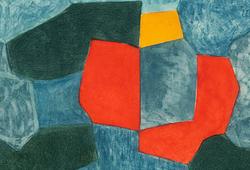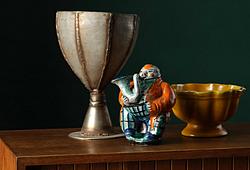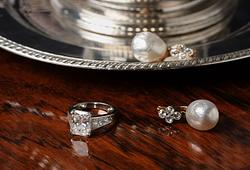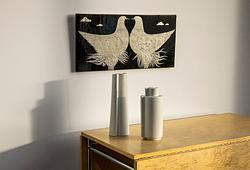Anders Zorn
"Söndagsmorgon" (Sunday morning)
Signed Zorn and dated Mora 1891. Oil on canvas 121 x 93 cm.
Saleroom notice
Addition to exhibition history:
Museum Behnhaus Drägerhaus, Lübeck, January 15 - April 15, 2012, "Anders Zorn - Der schwedische Impressionist", (under the title "Sonntagmorgen") cat. no 70 (illustrated full page in the catalogue p. 35 and p.164, essay p. 40 f.)
Import VAT
Import VAT (12%) will be charged on the hammer price on this lot. For further details please contact customer service +46 8-614 08 00.
Provenance
Publisher Rudolf Mosse's collection, Berlin; Merchant Albrecht Guttmans collection, Berlin (around 1907-16); Kunstsalon Rheinland, Berlin (approximately 1916-?), Consul Erik Brodins collection, Djursholm (from approximately 1920), Bukowski auktioner, auction no 300, Spring Auction, April 11 - 12, 1935, cat. no 59; Physician Erik Gustaf Berggren's collection, Jönköping; Beijers auktioner, Stockholm, "Höstauktion", 21 November 1984, cat. no 164; Bukowski Auktioner AB, auction 562, "Vårens Klassiska Auktion", June 14, 2011, cat. no 85; Private Collection, acquired at the above auction.
Exhibitions
Salon Gurlitt, Berlin, January 1892 (under the title "Sonntagmorgen in Dalekarlien").
(Possibly) "Gemälde, Zeichnungen und Radirungen von A. Zorn", Kunsthalle zu Hamburg, 1892.
Société Nationale des Beaux-arts, "Salon de 1893", Champ-de-Mars, Paris, 1893.
"Internationale Kunstausstellung des Vereins Bildender Künstler Münchens 'Secession' ", 1893, cat. no 646 (under the title "Sonntagmorgen in Dalecarlien, Schweden").
Konstnärsförbundet, Stockholm, 1894.
Finska konstföreningen, Helsingfors, 1899.
"Zweite Kunst-Ausstellung der Berliner Secession 1900", spring 1900, cat. no 348 (under the title "Sonntagsmorgen").
"Internationale Kunstausstellung Dresden 1901", April 20 - October 20, 1901, cat. no 777a (under the title "Sonntag Morgen").
"Erste internationale Mitglieder-Ausstellung der Berliner Akademie der Künste", Arnimsches Palais am Pariser Platz, Berlin, January 27 - March 9, 1907, cat. no 77 (under the title "Sonntagswäsche", then owned by Albrecht Guttman, Charlottenburg).
Liljevalchs konsthall, Stockholm, "Bruno Liljefors / Anders Zorn", April 10 - 25, 1920, cat. no 65 (then owned by consul Erik Brodin).
Liljevalchs konsthall, Stockholm, "Anders Zorn. Minnesutställning", March 1 -April 6, 1924, cat. no 62 (illustrated full page in exhibition catalogue).
Paris 1929, cat. no 130 (illustrated).
Zornmuseet, Mora, "Anders Zorn 1860-1960. Minnesutställning", February 18 - August 15, 1960, cat. no 103.
Museen für kunst und kulturgescichte der Hansestadt Lübeck Behnhaus, West Germany, "Anders Zorn", May 5 - June 17, 1962, cat. no 17 (under the title "Sonntagsmorgen").
West Germany, 1966.
The foundation Modums Blaafarvevaerk, Åmot, Norway, "Anders Zorn 1860 - 1920", May 12 - September 30, 1990, cat. no 66 (illustrated full page in colour, p. 105).
Prins Eugens Waldemarsudde, Stockholm, "Zorns mästerverk", October 23, 2010 - January 30, 2011.
Museum Behnhaus Drägerhaus, Lübeck, January 15 - April 15, 2012, "Anders Zorn - Der schwedische Impressionist", (under the title "Sonntagmorgen") cat. no 70 (illustrated full page in the catalogue p. 35 and p.164, essay p. 40 f.)
Literature
"Små konstböcker No 6. Anders Zorn -60 reproduktioner i tontryck efter fotografier af originalen", 1909, illustrated full page.
Karl Asplund, "Anders Zorn. His life and work", 1921, mentioned p. 35 (under the title "Sunday Morning") and illustrated full page in colour, Plate XIV.
Tor Hedberg, "Anders Zorn. Ungdomstiden 1860-1893", SAK, 1923, mentioned p. 132 and illustrated full page, p. 123.
Albert Engström, "Anders Zorn", 1928, illustrated full page in colour, p. 64.
Albert Engström, "Anders Zorn", 1942, illustrated full page in colour, p. 52.
"Konst i svenska hem", vol. 10, mentioned p. 538 under collection 940; Physician Erik Gustaf Berggren, Bymarksgatan 8, Jönköping.
Gerda Boëthius, "ZORN -Tecknaren, Målaren, Etsaren, Skulptören", 1949, mentioned p. 239, 294-295, 299, 387 and 529, listed in the register under the year 1891, p. 546.
Gerda Boëthius, "Zorn -Svensk och världsvandrare", 1959, mentioned p. 105.
Sixten Strömbom, "Nationalromantik och radikalism. Konstnärsförbundets historia 1891-1920", 1965, mentioned p. 72 and 488.
Hans Henrik Brummer, "Zorn -Människan och konstnären", 1977, mentioned p. 43, 106 and 174.
Anders Zorn, "Självbiografiska anteckningar" (published and commented by Hans Henrik Brummer), 1982, mentioned p. 196 and 215.
Cecilia Lengefeld, "Zorn -Resor, konst och kommers i Tyskland", 2000, mentioned p. 52 (under the title "Sonntagmorgen in Dalecarlien"), 103, 150, 188-189 and illustrated full page in colour, colour plate X and listed in exhibition documentation p. 317 ff.
Johan Cederlund (red.), "Zorn. Mästerverk", 2010, described by Birgitta Sandström Ph.D (former director of the Zornmuseum) p. 98 and illustrated full page in colour, p. 99.
More information
'Söndagsmorgon' was executed as an etching in 1892 or 1894 (Delteil 85, Asplund 86).
In the summer of 1891 Zorn spent a long period of of time in Mora. This was a particularly creative period for him. Several of his finest paintings of Dalecarlian women were executed then, and amongst these is this interior, which he entitled Söndagsmorgon. The painting depicts three girls who are getting ready for church on a sunny summer’s morning. They are all at different stages in their morning toilet. The girl in the foreground of the painting is washing herself using a basin, which she has placed on a chair. Another girl, dressed in the traditional Dalecarlian women’s summer attire with a light-coloured skirt and a green bodice, has placed her mirror by the little window and is putting up her hair in the customary Dalecarlian fashion with a red hairband. A third woman has already finished dressing and is sitting down to put on her shoes.
It is a childhood memory that Zorn recreates in the painting. In the small Mora cottages there were no private areas for taking care of one’s personal hygiene. In the old farming communities this was done, as were so many other things, in the shared rooms. The Dalecarlian women did not feel uncomfortable in front of the children and to a young Anders this scene was normal.
On the whole Zorn lived in a female-dominated environment. In the Zorn house in Mora there was his wife, Emma Zorn, and next door lived his mother, who had been widowed in 1885, with both his sisters. His household included several female domestic staff, of which a few resided in the house. In Stockholm there was Emma’s mother, who herself had been widowed in 1878, and she only had female servants working for her. Of course there were men around – Zorn’s maternal grandfather played an important role during his childhood and there was Verner Rylander who at the end of the 1800s was employed as Zorn’s handyman. But for the most part, Zorn’s world was a female one.
As an adult Zorn did not have the same easy access to women’s daily lives, but he restaged it by having models act out scenes he remembered from his youth. Zorn considered his childhood to be a kind of Arcadian ideal and it played a significant role in his artistic practice throughout his life. To him the past was true and authentic, but he would argue that since the time of his childhood a vulgarisation of manners and customs had permeated society. A great deal of his production is intended as a celebration of the past.
In 'Söndagsmorgon' Zorn has used a composition that he had previously returned to on several occasions. The high horizon, introduced by the impressionists, and the cropping of the motif, an influence from Japanese art, gave Zorn the possibility to depict the three people in the relatively small room without it feeling either cramped or forced. In this painting, Zorn’s ability to unite subject and composition is superbly expressed.
Birgitta Sandström
PhD, former director of the Zorn Collections, Mora.
Artist
Anders Zorn, born in Mora in 1860, showed artistic talent from a young age. In 1875, he traveled to Stockholm and became a student at the then Slöjdskolan (now Tekniska högskolan) in Stockholm, and shortly after, he joined the Royal Academy of Fine Arts. Initially, Zorn had aspirations of becoming a sculptor, but soon watercolor painting took over, becoming his primary medium until 1887. At the student exhibition in 1880, Zorn had his breakthrough with the watercolor painting "I sorg." The following year, he gained international acclaim as a portrait painter. His watercolor painting reached its pinnacle during this period, and his most famous work from this time is "Vårt dagliga bröd” from 1886. Shortly thereafter, Zorn transitioned to oil painting, which was met with immediate success. Zorn's reputation mainly rested on his portrait art, and he portrayed many notable figures, including presidents. For instance, he created an etching of Theodore Roosevelt. His etchings significantly contributed to his success. In the late 1880s, Zorn began working in the genre that would increasingly become his trademark: nude figures in outdoor settings. He had long been fascinated by the movement of water and the reflections of light on its surface. Now, he added the complexity of placing a model near or in the water, aiming to depict a synthesis between nature and humanity. In 1896, Zorn and his wife moved back to Sweden and settled in Zorngården in Mora. This move sparked a renewed interest in his homeland, which would be reflected in his future paintings. Among the artist's scenes from the Mora region, portraying its local customs and ancient traditions, "Midsommardansen" holds the highest value according to Zorn himself. Today, the painting can be found at the National Museum.
Read more
























































